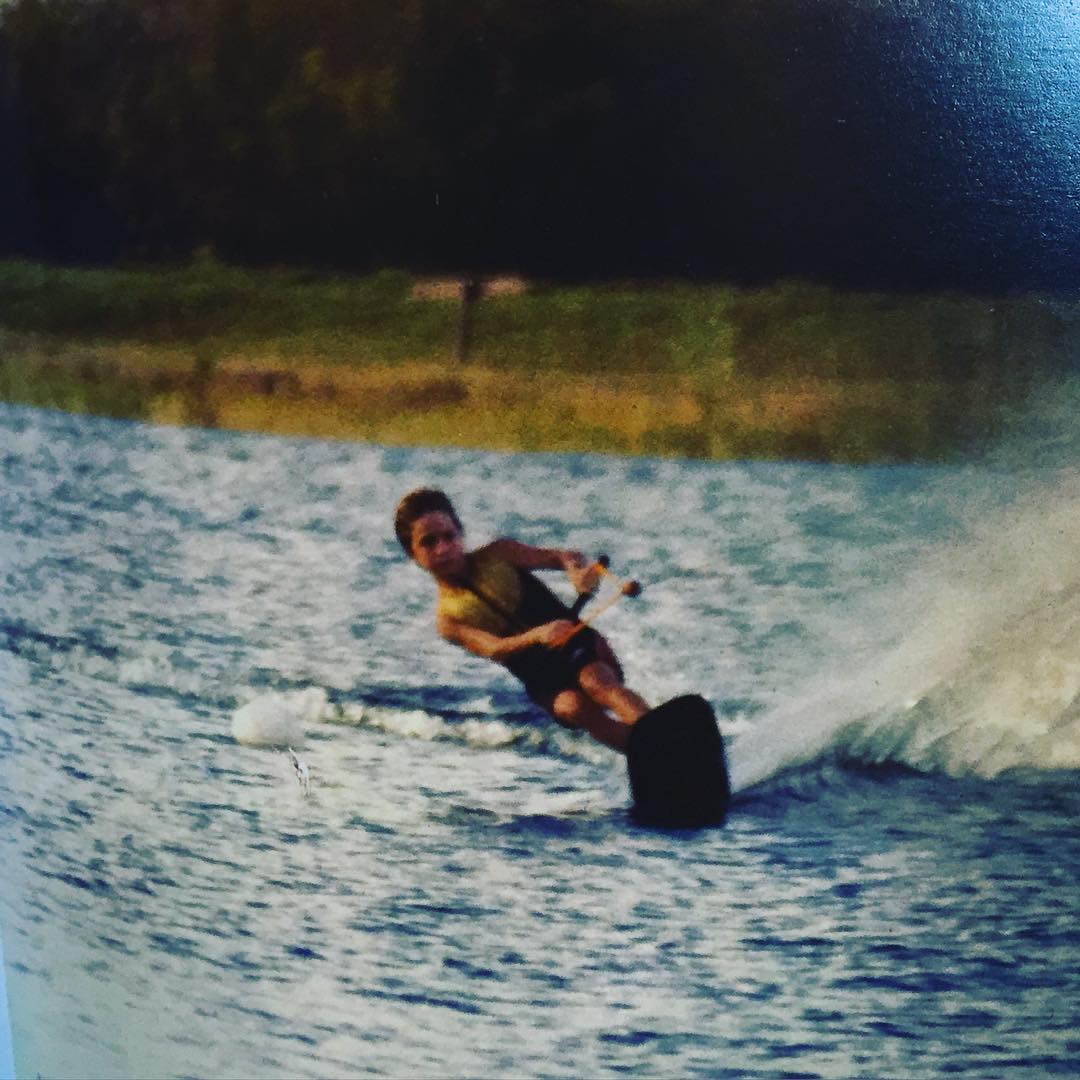
11 May FULL CIRCLE – An Interview with Darin Shapiro (Part 1)
Twenty-seven years. Yep, you read that right! It’s been twenty-seven years since Darin Shapiro first strapped on a wakeboard, and never looked back. It was fun watching his return to the competitive stage a few years ago, even if just for a brief moment. But life has come full circle for Darin, and nowadays, he’s enjoying it at a more conventional pace. Besides being a father and focusing on his family, he still coaches at www.ridethespot.com and Lake Rise when he’s not working in real estate with his wife, or perfecting his Brazilian Jiu Jitsu skills.
And after all these years, the Scud still loves charging into the wake and sending it way out into the flats. Sit back and enjoy getting firsthand insight on all that is wake from the winningest wakeboarder in history.
WHF: You’ve been in the sport from virtually the very beginning. And you’ve never hidden the fact that you came from a waterski background, despite there being a lot of tension between skiers and wakeboarders in the early years. Did you ever feel caught in the middle and had to pick a side?
DS: That’s a great question, because I don’t think I’ve been asked that question but there’s definitely a little bit of story there, and here’s the short version. I water-skied pretty heavily through the late 80’s. I also grew up surfing, and skateboarded, as a kid, all vert ramp stuff. When a wakeboard came along, I took a good look at it and it was interesting to me because I was already riding a trick ski like we ride a wakeboard. And by that, I mean I was pulling way out to the side of the boat, doing backrolls as big as I could. And I had a real knack for doing a bunch of flips on a trick ski that hadn’t been done on a wakeboard yet.
But the people I was waterskiing with laughed when I said I was interested in it. I said, “It looks kind of cool, and they even have a contest in Hawaii. I’d like to go to that.” And they were just kind of like, “You’re going to stop waterskiing to wakeboard?” And I’ve got to be honest. I really didn’t give a crap. They were looking at me like, “Are you serious???” And of course, they were looking at it like it might as well be a kneeboard. But I already felt like I wanted to do some of those things on a trick ski. I wanted to grab and go big. I didn’t want to ride it like a trick ski. I was never a super high-level trick skier because the way I saw trick skiing wasn’t traditional. That’s one of the reasons why a wakeboard was such a cool, perfect fit.
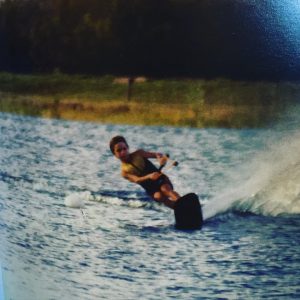
Darin at Ski Rixen in 1984 (Photo Andy Lazarus)
But yeah, there was a moment there, where water skiers looked at me like, “Are you serious??” And was I like, “I don’t care what you think. I’m going to Hawaii to wakeboard, do the contest and see what happens.” I had waterskied my whole life and never won any money in a contest. Then I went to my first wakeboard contest, came home with a check and had way more fun! I had a bunch of guys who were doing something because it was cool and fun as opposed to a bunch of people who were very uptight in comparison about how seriously they treated a sport. And I was only like 17 at the time, so what do you think I’m going to pick?
WHF: Did you ever have to defend your waterski background to wakeboarders?
DS: No, I don’t recall really ever doing that. I think having the waterski background and then entering wakeboarding, I was way ahead of the curve with a lot of the skills that I already had. That allowed me to have some respect coming from the waterski background because I was inventing tricks and I had the ability to take what I knew about holding on to a handle right into wakeboarding. As opposed to a guy who was a windsurfer or a surfer, getting hold of a handle and saying, “Hmmm, what do I do with this?” So I felt I had a little bit of respect from the beginning.
WHF: During your career, you’ve ridden for multiple companies, starting with Hyperlite in 1991. Then you changed to O’Brien after the 1998 Pro Tour season and stayed there until you switched to Liquid Force around early 2007, before you retired. Now, you’re with Ronix. Out of all the boards you have ridden and pro models you’ve had, which one was your true favorite and why?
DS: I like different boards for different reasons because they remind me of different periods in my life. Along with that, the different influences the shaper puts into their board can also influence the style of tricks, or the way your riding can come off the board too. The board gives you feedback and can help you with certain dynamics of the way you perform. So I would say I never had a favorite. However, working with Jimmy Redmond, I thought we had a very close relationship to what we thought the boards we were designing together should do. I definitely felt liked when I worked with him, I had some real input and Jimmy’s skills were really coming through. I felt at that point in my career, I had a board in my hand that was really a good fit for me.
At Hyperlite, everything was such a new thing, I think Herb had a vision and I was a lot younger at the time. I was just letting Herb do his thing because Herb was the mad scientist in his own right, and the stuff he would develop would clearly work. It wasn’t the kind of thing where I was so hands-on at the time with designs.
With Chris Johnson at O’Brien, we put together a board called the Demented. That’s for sure one of my favorites. Just as far as performance, that was a special board for sure. It came out of the press, magic!
This year, I’m riding the Ronix Code 21 because it’s a really good fit for my riding.
WHF: You were known for being a very diligent athlete who took care of himself when it came to your career (preparation, nutrition, training, recovery, etc…). How did that all come about? Was it from your waterskiing background or something else?
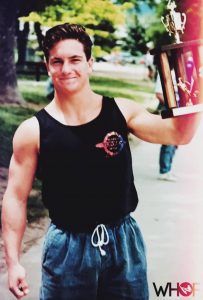
1992 World Champion (Photo Tommy Phillips)
DS: When I was 7 or 8 years old, I saw the movie “Rocky.” Something about that movie, showing him training and being an athlete, I don’t know. When I think back to being a really young kid and what an impression that movie had made on me. I would do the same thing as an 8 year old. I’d get up and run, and I wanted to be that kind of athlete. Even from a young age, I had that kind of discipline. If I thought there was something that was going to help me be a better athlete or more knowledge about something that was going to benefit me, that’s all I was focused on. It just meant so much to me that if I was going try to be something, I was really going to try to be the best I could be.
WHF: In the December 1995 issue of WakeBoarding magazine, Hyperlite ran an ad that said “Darin Shapiro. The most hated rider on Tour, because he’s never been beaten.” Where did your competitiveness come from?
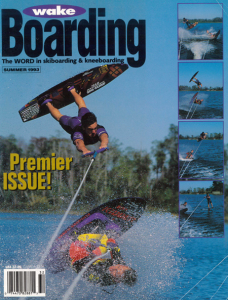
First issue of WakeBoarding magazine – Summer 1993
DS: I have no idea! I didn’t grow up with parents who were athletes. Also, growing up with waterskiing, racing BMX, or any sports I was doing, I wasn’t the best, clearly. I’d get into these sports and I was always a little kid, first of all. And as far as I was concerned, not being raised with athletic or competitive parents, I don’t know where being really driven came from because early on I didn’t really have any mentors until I hooked up with Mike Ferraro. But I was always the kind of kid who wouldn’t quit or give up, even if I wasn’t the best. I think I was strong-willed. I was lucky enough to have the opportunity to be introduced to watersports, and just instantly it was just kind of a fit and I could feel it. Then, that same drive, as things started to happen, only got stronger. I had the support of my parents, not the help or skill, but I had the support. And they just let me loose. It was like a subconscious effort, it was just kind of happening.
WHF: You’ve won every notable honor there is in the sport. Is there one particular victory or honor that really means the most to you, and why?
DS: I would say the most memorable was back in 1997. I had missed the entire season with an ankle injury in 1996, and while I was hurt I watched the sport progress quite a bit. There were new mobes, new equipment, new riders, a lot was happening and it seemed to have progressed a lot while I was laid up. People may not know it but no matter how high up the food chain you are, as soon as you’re on the sideline you’re not part of it. You’re swept to the side a little bit. You know what I mean? So that’s kind of a hard thing. But as soon as I started to get well at the end of 96’, I got back on the board and I relentlessly went at it until the first Pro Tour contest of 1997 in Altamonte Springs. I had just gone berserk with my training. I had been trying to master the first double flip, all these S-Bends, Crow Mobes and all the new stuff that was happening. So, to go from where I had been a year before, and then being out for a season, when I came back in 97’ I had to qualify for my comeback event. I won qualifying, competing against new faces that I had never seen before. I ended up winning the event with the first double flip off the double up and I just felt like it was really a major personal accomplishment. I felt that I had proved something to myself that I had never done before.
WHF: In an ESPN interview for the 1998 Worlds, you stated some of your career goals when you first started. You said in 1997 you achieved all the ones you hadn’t made. You wanted to win the Masters three times and the Tour five times. In the end, you earned four Masters and six Tours. Is there any goal that you feel you didn’t achieve?
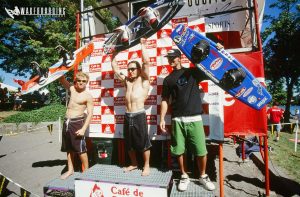
1997 Portland Pro Tour Podium – Photo Kelly Kingman
DS: Without sounding egotistical, no. I achieved more than I expected to. I think on a personal note, there was a part of a disconnect with maybe how I could have been more of a team player with some of my sponsors. You know as I look back as an athlete, I was extremely focused on competing. But now, I feel like if I had a little bit more long-term vision of what the companies I was working for needed, a bigger picture of what an athlete could do for the company, I think it would’ve helped me help the companies more and may have provided a better opportunity for me as I grew older.
WHF: In the extra footage of High Wake Drifters, back in 1996, you were quoted as saying “In 15-20 years, we’re all gonna be wishing we were doing what we’re doing now”. It’s now past the 20-year mark and you’re still killing it on a wakeboard. Knowing what you know now, if you could go back and give yourself some advice, what would it be?
DS: Take the time to nurture all those relationships and slow down to enjoy the view. Because when you’re just so wrapped up about getting to the contests and trying to win money, and get back home, it’s a bit more of a blur. I think
I would’ve enjoyed it more if I would have slowed things down and still had more time with more people.
WHF: Back in the day, it was portrayed that there was a riff between you and some of the riders, most notably Scott Byerly. But on the ESPN coverage, it would show you both talking cordially to each other. Was there any truth to that?
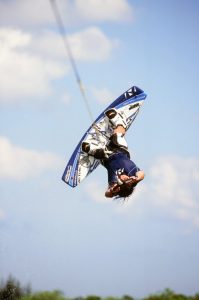
S-Bend 1997 (Photo Kelly Kingman)
DS: There was never any truth to that. I think we were clearly different individuals and people probably just looked at that and made some assumptions. But Scott and I have always had total respect for each other, even from early on.
WHF: Is there anyone in the wake community that you honestly didn’t get a long with?
DS: Hmmm……let me think (long pause). I can’t think of anyone.
WHF: Although it was said it was meant to be a joke, what did you think about the whole “New Crew“ thing?
DS: I just thought they were a bunch of kids having fun. I think sometimes they had a mean sense of humor, but that’s just kids. I think what they were doing was to just try to get a reaction from everyone. You know, that was their thing.



Sorry, the comment form is closed at this time.